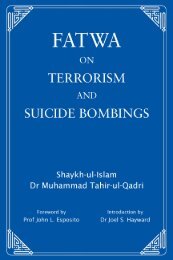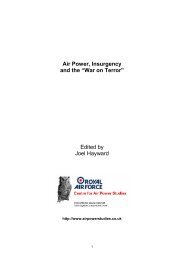Air Power, Insurgency and the âWar on Terrorâ - Prof. Joel Hayward's ...
Air Power, Insurgency and the âWar on Terrorâ - Prof. Joel Hayward's ...
Air Power, Insurgency and the âWar on Terrorâ - Prof. Joel Hayward's ...
You also want an ePaper? Increase the reach of your titles
YUMPU automatically turns print PDFs into web optimized ePapers that Google loves.
The <str<strong>on</strong>g>Air</str<strong>on</strong>g> <str<strong>on</strong>g>Power</str<strong>on</strong>g> <strong>Prof</strong>essi<strong>on</strong>: Adapti<strong>on</strong>s to C<strong>on</strong>tinuity <str<strong>on</strong>g>and</str<strong>on</strong>g> Change in <str<strong>on</strong>g>the</str<strong>on</strong>g> Strategic Envir<strong>on</strong>ment<br />
is typical of those who claim that operati<strong>on</strong>al innovati<strong>on</strong> “is inevitably reduced by doctrine<br />
because doctrine explicitly teaches <str<strong>on</strong>g>the</str<strong>on</strong>g> nature of operati<strong>on</strong>s to be of a particular kind <str<strong>on</strong>g>and</str<strong>on</strong>g><br />
not ano<str<strong>on</strong>g>the</str<strong>on</strong>g>r”. O<str<strong>on</strong>g>the</str<strong>on</strong>g>rs challenge <str<strong>on</strong>g>the</str<strong>on</strong>g> noti<strong>on</strong>s that professi<strong>on</strong>al knowledge is cumulative,<br />
suggesting instead that paradigm shifts can occur that call into questi<strong>on</strong> <str<strong>on</strong>g>the</str<strong>on</strong>g> utility of<br />
“traditi<strong>on</strong>al” assumpti<strong>on</strong>s about strategy <str<strong>on</strong>g>and</str<strong>on</strong>g> <str<strong>on</strong>g>the</str<strong>on</strong>g> capabilities in <str<strong>on</strong>g>the</str<strong>on</strong>g> inventories of modern<br />
state-of-<str<strong>on</strong>g>the</str<strong>on</strong>g>-art air forces. Indeed, it could be said that air power as a c<strong>on</strong>cept came into<br />
being as a result of just such a paradigm shift. There is general recogniti<strong>on</strong> that <str<strong>on</strong>g>the</str<strong>on</strong>g> socalled<br />
“revoluti<strong>on</strong> in military affairs,” which marries intelligence systems with precisi<strong>on</strong><br />
strikes, now provides technologically-capable western armed forces with a decisive edge<br />
in symmetrical state-<strong>on</strong>-state forms of warfare. Corresp<strong>on</strong>dingly, some critics argue <str<strong>on</strong>g>the</str<strong>on</strong>g><br />
so-called “revoluti<strong>on</strong> in political affairs” <str<strong>on</strong>g>and</str<strong>on</strong>g> <str<strong>on</strong>g>the</str<strong>on</strong>g> prevalence of “4th Generati<strong>on</strong>” n<strong>on</strong>state<br />
actors present asymmetric threats against which high-technology <str<strong>on</strong>g>and</str<strong>on</strong>g> precisi<strong>on</strong><br />
are ill-suited, suggesting that armed forces now lack <str<strong>on</strong>g>the</str<strong>on</strong>g> c<strong>on</strong>ceptual tools <str<strong>on</strong>g>and</str<strong>on</strong>g> physical<br />
capabilities required to defeat <str<strong>on</strong>g>the</str<strong>on</strong>g> insurgencies making up <str<strong>on</strong>g>the</str<strong>on</strong>g> Global War <strong>on</strong> Terror. 25<br />
O<str<strong>on</strong>g>the</str<strong>on</strong>g>r areas of c<strong>on</strong>cern are <str<strong>on</strong>g>the</str<strong>on</strong>g> practical difficulties encountered in employing military<br />
force as part of a coherent inter-agency “comprehensive approach” against insurgents<br />
employing asymmetric strategies. Here, critics have pointed to inter-agency fricti<strong>on</strong>s,<br />
competiti<strong>on</strong> <str<strong>on</strong>g>and</str<strong>on</strong>g> misunderst<str<strong>on</strong>g>and</str<strong>on</strong>g>ing as key impediments to <str<strong>on</strong>g>the</str<strong>on</strong>g> achievement of <str<strong>on</strong>g>the</str<strong>on</strong>g><br />
political, operati<strong>on</strong>al <str<strong>on</strong>g>and</str<strong>on</strong>g> tactical requirements of COIN operati<strong>on</strong>s. 26 Finally, air forces<br />
<str<strong>on</strong>g>and</str<strong>on</strong>g> nati<strong>on</strong>al militaries as a whole are criticised for failing to invest physical <str<strong>on</strong>g>and</str<strong>on</strong>g> intellectual<br />
resources into COIN campaign requirements. Some, for example, claim that acquisiti<strong>on</strong><br />
<str<strong>on</strong>g>and</str<strong>on</strong>g> retenti<strong>on</strong> of highly capable offensive air capabilities reflect organisati<strong>on</strong>al vested<br />
interest in expensive <str<strong>on</strong>g>and</str<strong>on</strong>g> inappropriate high-technology platforms ra<str<strong>on</strong>g>the</str<strong>on</strong>g>r than <str<strong>on</strong>g>the</str<strong>on</strong>g> needs<br />
of c<strong>on</strong>temporary COIN operati<strong>on</strong>s. This reflects a c<strong>on</strong>cern that, since 1945, insurgencies<br />
have been more widespread than c<strong>on</strong>venti<strong>on</strong>al wars 27 but most air forces remain primarily<br />
organised, trained, educated <str<strong>on</strong>g>and</str<strong>on</strong>g> equipped to fight c<strong>on</strong>venti<strong>on</strong>al war.<br />
The specific attributes of COIN present particular challenges for air power practiti<strong>on</strong>ers<br />
<str<strong>on</strong>g>and</str<strong>on</strong>g> <str<strong>on</strong>g>the</str<strong>on</strong>g> military professi<strong>on</strong> as a whole. Whichever “nati<strong>on</strong>al principles” are adopted as<br />
a framework for COIN operati<strong>on</strong>s, <str<strong>on</strong>g>the</str<strong>on</strong>g>y all point to c<strong>on</strong>ceptual, practical, inter-agency<br />
<str<strong>on</strong>g>and</str<strong>on</strong>g> instituti<strong>on</strong>al complexities when compared to symmetrical forms of warfare. These<br />
complexities arise from <str<strong>on</strong>g>the</str<strong>on</strong>g> political nature of insurgencies, <str<strong>on</strong>g>the</str<strong>on</strong>g> unique challenges<br />
in creating co-ordinated government counter-insurgency machinery, difficulties in<br />
generating intelligence, identifying appropriate mechanisms to separate insurgents<br />
from <str<strong>on</strong>g>the</str<strong>on</strong>g> “people,” <str<strong>on</strong>g>and</str<strong>on</strong>g> issues of proporti<strong>on</strong>ality when <str<strong>on</strong>g>the</str<strong>on</strong>g> military instrument of state<br />
policy is applied.<br />
28<br />
<str<strong>on</strong>g>Air</str<strong>on</strong>g> <str<strong>on</strong>g>Power</str<strong>on</strong>g>, <str<strong>on</strong>g>Insurgency</str<strong>on</strong>g> <str<strong>on</strong>g>and</str<strong>on</strong>g> <str<strong>on</strong>g>the</str<strong>on</strong>g> “War <strong>on</strong> Terror”





